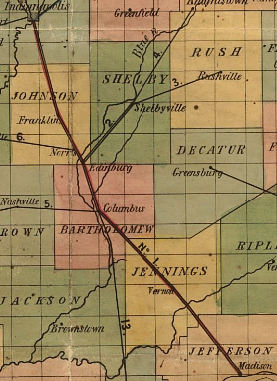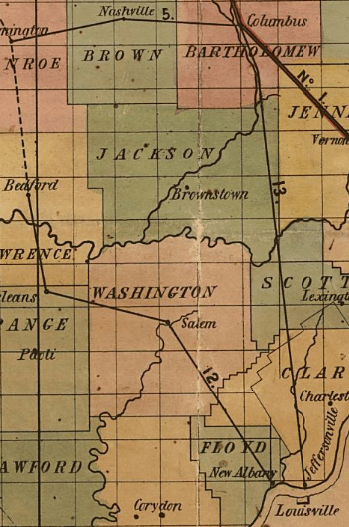One of the beautiful things of the internet, one of the things that make doing something like the Indiana Transportation History blog so easy, is the access to a world of information. Yes, some is accurate, and some isn’t. But my favorite resources, as I have shown over the past almost two years, is maps. While maps can be wrong at times, or more to the point, based on “future” information that doesn’t come to be, they are still a great resource if you can figure where they went wrong.
Today, I found another map that grabbed my interest. Looking at a map of railroads in Indiana, even today, there are railroads all over the state. A railroad map from the turn of the 20th Century is a spider web of routes crossing the state in all kinds of directions. But the map that I found today is one of Indiana in 1850. It is an interesting look what was, and how many changes have come about in the 170 years since it was printed.
When railroads started being built in the state, just like everywhere else, it was a jumble of little companies, usually with destination cities in the company title. There were 15 railroads on the map at the time, with some that were proposed. One of them was in Ohio, but would later be part of an Indiana system when it was completed. The map that I found showed the railroad routes as straight lines, not the actual routes themselves. I am going to cover them in the order the map numbered them.

Number 1: Madison and Indianapolis Railroad. I have covered this railroad many times, as it was the first long distance railroad built in Indiana. The engineering of this route, which included the steepest railroad tracks in the nation, was top notch at the time. Although it was originally been on the cheap, using iron strapped rails instead of the “T” rail that would become standard (and much safer) later. In the end, it would become part of the Pennsylvania Railroad.
Number 2: Shelbyville Lateral Branch. This line was built as a feeder road to the Madison & Indianapolis. Its history isn’t terribly long. It connected the Madison & Indianapolis at Edinburgh to Shelbyville, opening up farm produce from Shelby County to the world at large. The railroad, depending on what history you read because it is very spotty, would last around five years before it was abandoned.
Number 3: Shelbyville & Rushville Railroad. Shelbyville was a “rail center” for a little while in the 1850’s and 1860’s. This route connected the two title towns, opening Rush County to the markets available on the Madison & Indianapolis.
Number 4: Shelbyville & Knightstown Railroad. Another short lived railroad, that would open southern Henry County to the same markets served by the above three. This company would last less than a decade, according to the source. Again, the history is spotty about this road at best. Later, part of route would become part of a railroad again, but instead of connecting Knightstown to Shelbyville, it would connect to Rushville.

Number 5: Columbus, Nashville & Bloomington. Trying to find any history on this road is difficult at best. I am not even sure if it existed at all. This will require more research.
Number 6: Martinsville Branch Railroad. Another road, like the one above. History is hard to find like the one above. It connected the Madison & Indianapolis to Martinsville. Later, the same connection would be made, in 1853, from the M&I at Franklin to Martinsville. That railroad would would be the Fairland, Franklin & Martinsville.

Number 7: Indianapolis & Bellefontaine Railroad. This route connected Indianapolis to Pendleton, Anderson, Muncie and Winchester to ultimately Bellefontaine, Ohio. Down the road, this would be one of the founding parts of the Big Four Railroad. It is still in use today as part of CSX.
Number 8: Indianapolis & Peru Railroad. Today, this is mostly known as the Nickel Plate connecting Indianapolis, Noblesville, Tipton, Kokomo and Peru. Or at least what’s left of it. At one point, for about nine months, it was consolidated with the Madison & Indianapolis creating a route from Madison to Peru under one umbrella. Shareholders, and the courts, put an end to that marriage, creating two separate companies again.

Number 9: Indianapolis & Lafayette Railroad. Another constituent part of what would become the Big Four Railroad. At one point, at the Indianapolis end, the line came down alongside the Central Canal. It would be also be the scene of a large train wreck that would kill members of the Purdue University football team (Part 1 and Part 2).
Number 10: Lafayette & Crawfordsville Railroad. This railroad would later become part of the Chicago, Indianapolis & Louisville, later known as the Monon. At the end of this article, I will show the only proposed railroad that in included on this map, which would be a connecting route from Crawfordsville to Bedford, thus creating the remaining part of the Monon mainline through western Indiana.

Number 11: Terre Haute, Indianapolis & Richmond Railroad. The original plan for this railroad was to connect the entire state, east to west, following roughly the National Road corridor. It would never be built past Indianapolis. Over the years, it would become part of the Pennsylvania Railroad.

Number 12: New Albany & Salem Railroad. This would be the southern end of what would become the Monon. There were several companies between the New Albany & Salem and the Monon. I covered the history of the Monon in two parts, part 1 and part 2.
Number 13: Jeffersonville & Columbus Railroad. Most references to this road refer to it as the Jeffersonville, or “J.” The plan was to build the line all the way to Indianapolis. The problem came with the management of the Madison & Indianapolis. As the first railroad, the M&I assumed the attitude that they were the kings of the state’s railroads and others, especially direct competitors like the “J,” should just be good little kids and do what they are told.
There is a story about the M&I not wanting to help another railroad, because they weren’t in business to provide charity to other companies. The company they turned down would be the THI&R, which would be far more successful than the M&I in the end.
The M&I refused to cooperate with the J. So, ultimately, the J not only invested in feeder lines, taking traffic from the M&I, they started building a parallel track to the M&I. Ultimately, the J would end up buying the struggling M&I. And, like the M&I, would become part of the Pennsylvania system.

Number 14: Lawrenceburg & Greensburg Railroad. This road was built to connect the markets of Decatur and Ripley Counties to the markets at Cincinnati. Ultimately, the plan was to build the road all the way to Indianapolis, allowing a more direct route from the Hoosier capital to the Queen City of the Ohio. Traffic would be barged from Lawrenceburg to Cincinnati, which was faster than the already in place barged traffic from Madison to Cincinnati.
Number 15: Cincinnati, Hamilton & Dayton Railroad. The only reason that I am mentioning this is because it would be the foundation of what would ultimately become the Baltimore & Ohio connecting Indianapolis to Cincinnati directly.

As mentioned above, the only proposed railroad on this map is the future Monon route connecting Bedford to Crawfordsville. Several towns along the proposed route would not be serviced by any other railroad company for years. And today, most of this route no longer exists, having been given back to the locals when the bigger companies were created, and the route became excessively redundant.
There is one more transportation facility included on this map. The Wabash & Erie Canal from Evansville to Fort Wayne and beyond is marked on it.
The entire map that I used for this article is available here: Railroad map of Indiana, by Col. Thomas A. Morris, Civil Engineer, | Library of Congress (loc.gov)





















